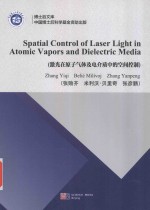

激光在原子气体及电介质中的空间控制PDF电子书下载
- 电子书积分:10 积分如何计算积分?
- 作 者:张贻齐(ZHANGYIQI),米利沃·贝里奇(BELICMILIVOJ),张彦鹏(ZHANGYANPENG)著
- 出 版 社:北京:科学出版社
- 出版年份:2016
- ISBN:9787030488725
- 页数:206 页
Chapter 1 BASIC THEORY 1
1.1 The paraxial wave equation 1
1.2 Susceptibilities in atomic vapors 3
REFERENCES 8
Chapter 2 SPATIAL LIGHT CONTROL 10
2.1 Photonic topological insulators in atomic ensembles 10
2.1.1 Theoretical model 11
2.1.2 Refractive index change 13
2.1.3 Topology of the photonic band gap structure 14
2.1.4 Photonic Floquet topological insulator 17
2.1.5 Discussion 20
2.1.6 Summary 23
Appendix Ⅰ:Band structure of a honeycomb lattice-the tight-binding method 24
AⅠ.1 Full band structure 24
AⅠ.2 Strained band structure 27
Appendix Ⅱ:Band structure of a honeycomb lattice-the plane-wave expansion method 29
2.2 Talbot effect of multi-wave mixings 31
2.2.1 Theoretical model and analysis 33
2.2.2 Suppression and enhancement conditions 35
2.2.3 Talbot effect of multi-wave mixing signals 37
2.2.4 Summary 42
2.3 Nonlinear Talbot effect from rogue waves 42
2.3.1 Basic rogue wave solutions 43
2.3.2 One-dimensional case 45
2.3.3 Two-dimensional case-linear Talbot effect 47
2.3.4 Two-dimensional case-nonlinear Talbot effect 51
2.3.5 Summary 57
2.4 Beam splitter and combiner based on Bloch oscillations 57
2.4.1 Waveguide array with m≤0 members modulated 59
2.4.2 Beam splitter based on the V-type modulated waveguide array 61
2.4.3 Beam combiner based on the ?-type modulated waveguide array 62
2.4.4 Summary 64
REFERENCES 65
Chapter 3 NONLINEARITY-INDUCED SPATIAL MODULATION 75
3.1 Introduction 75
3.2 Optical vortices induced in atomic vapors 76
3.2.1 Theoretical model 77
3.2.2 Simple vortex and necklace incidence 79
3.2.3 Azimuthon incidence 81
3.2.4 The enhancement region 85
3.2.5 The liquid-like behavior of light and potential experiment 87
3.2.6 Summary 87
3.3 Interactions between incoherent solitons 88
3.3.1 Theoretical model 88
3.3.2 Numerical simulations and discussions 90
3.3.3 Summary 95
3.4 Azimuthons in weakly nonlinear waveguides 95
3.4.1 Theoretical model 95
3.4.2 Rotating localized dipoles 97
3.4.3 Rotating higher order localized modes 105
3.4.4 Summary 106
REFERENCES 107
Chapter 4 SPATIAL CONTROL OF NOVEL LIGHT BEAMS 114
4.1 Introduction 114
4.2 Interactions between Airy beams 114
4.2.1 Theoretical model 115
4.2.2 Interactions of Airy beams 118
4.2.3 Interactions of nonlinear accelerating beams 121
4.2.4 Interactions of different accelerating beams 123
4.2.5 Summary 125
4.3 Airy beams with initial velocity 126
4.3.1 One-dimensional case 126
4.3.2 Two-dimensional case 130
4.3.3 A little discussion 132
4.3.4 Summary 132
4.4 Dual accelerating Airy-Talbot recurrence effect 133
4.4.1 Theoretical model 133
4.4.2 Numerical simulations 134
4.4.3 Superposition of finite-energy Airy beams 137
4.4.4 Summary 138
4.5 Nonparaxial self-accelerating beams 139
4.5.1 Theoretical model 140
4.5.2 Mathieu beams 141
4.5.3 Weber beams 143
4.5.4 Fresnel integrals 145
4.5.5 Summary 146
4.6 Fresnel diffraction patterns as self-accelerating beams 147
4.6.1 One-dimensional case 147
4.6.2 Two-dimensional case 152
4.6.3 Summary 153
4.7 Spatial control of light due to harmonic potential 154
4.7.1 Theoretical model 155
4.7.2 Solutions and numerical simulations 156
4.7.3 Chirped finite energy Airy beams 162
4.7.4 Two-dimensional Airy beams 166
4.7.5 Two-dimensional case-the rotating light 168
4.7.6 Summary 174
4.8 Self-Fourier beams 174
4.8.1 Theoretical model 175
4.8.2 Discussion 177
4.8.3 Analytical solutions 179
4.8.4 Self-Fourier beams 181
4.8.5 Summary 184
4.9 Spatial control in a fractional Schr?dinger equation 185
4.9.1 Theoretical model 186
4.9.2 One-dimensional case 188
4.9.3 Two-dimensional case 191
4.9.4 Summary 192
REFERENCES 193
Chapter 5 CONCLUSION AND OUTLOOK 202
5.1 Summary 202
5.2 Outlook 203
REFERENCES 204
编后记 206
- 《激光加工实训技能指导理实一体化教程 下》王秀军,徐永红主编;刘波,刘克生副主编 2017
- 《高含硫气藏开发腐蚀控制技术与实践》唐永帆,张强 2018
- 《先进激光加工技能实训》肖海兵主编 2019
- 《钢铁行业污染特征与全过程控制技术研究》周长波等 2019
- 《生活垃圾焚烧飞灰中典型污染物控制技术》朱芬芬等编著 2019
- 《农田温室气体排放评估与减排技术》江丽华编著 2019
- 《钢铁烧结烟气多污染物过程控制原理与新技术》甘敏,范晓慧著 2019
- 《真菌毒素控制集成解决方案 第二届MycoKey国际真菌毒素大会论文集》冯洁 2018
- 《冷原子 热太阳》中科院SELF格致论道讲坛著 2019
- 《无机元素原子光谱分析样品预处理技术》吴瑶庆 2019
- 《漫画说河西走廊》嘻夫子著;皮蛋贝爷绘 2019
- 《玛德琳》(美)路德维格·贝梅尔曼斯文图 2019
- 《政治的新科学》(美)埃里克·沃格林(Eric Voegelin)著 2019
- 《玛德琳的救命狗》(美)路德维格·贝梅尔曼斯文图 2019
- 《基于国家主流意识形态安全的高校思想政治教育资源优化配置与综合创新研究系列丛书 思想政治教育优秀传统文化认同研究》杨贝责任编辑;(中国)张卫良 2019
- 《有一个地方叫夏》(意)马西米利亚诺·弗雷扎托文图 2019
- 《船舶保安意识与职责》赵传贝主编 2018
- 《自制四声道扩音机》(日)奥沃清吉著;曾焕然编译 1977
- 《风湿病中医治疗心法》贝新法编著 2013
- 《外族的智慧 希腊化的局限》(意)阿纳尔多·莫米利亚诺著;晏绍祥译 2013
- 《指向核心素养 北京十一学校名师教学设计 英语 七年级 上 配人教版》周志英总主编 2019
- 《《走近科学》精选丛书 中国UFO悬案调查》郭之文 2019
- 《北京生态环境保护》《北京环境保护丛书》编委会编著 2018
- 《中医骨伤科学》赵文海,张俐,温建民著 2017
- 《美国小学分级阅读 二级D 地球科学&物质科学》本书编委会 2016
- 《指向核心素养 北京十一学校名师教学设计 英语 九年级 上 配人教版》周志英总主编 2019
- 《强磁场下的基础科学问题》中国科学院编 2020
- 《小牛顿科学故事馆 进化论的故事》小牛顿科学教育公司编辑团队 2018
- 《小牛顿科学故事馆 医学的故事》小牛顿科学教育公司编辑团队 2018
- 《高等院校旅游专业系列教材 旅游企业岗位培训系列教材 新编北京导游英语》杨昆,鄢莉,谭明华 2019
